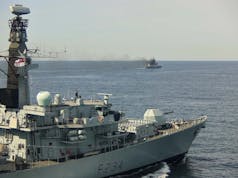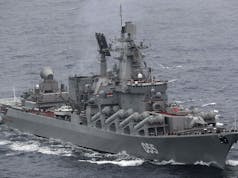HMS Queen Elizabeth left Portsmouth on November 10 bound for operations in northern European waters with F-35 Lightning jets, say the Royal Navy.
The aircraft carrier recently returned from the United States where she hosted a high-profile security conference between the UK and US in New York, in place of her currently out-of-action sister ship.
A sailor onboard HMS Kent captured a video of an F-35 taking-off from HMS Queen Elizabeth.
F35 takeoff from @HMSQNLZ at sea whilst part of the Carrier Strike Group @COMUKCSG #Invicta pic.twitter.com/kwHlHpwEMk
— HMS Kent (@hms_kent) November 20, 2022
HMS Queen Elizabeth has now sailed for the next phase of her autumn programme, which will see her lead a powerful Carrier Striker Group of warships, helicopters and F35B stealth jets on Operation Achillean.
According to a Royal Navy statement:
“The Carrier Strike Group will work closely with NATO and Joint Expeditionary Force allies as the UK underscores its commitment to safeguarding European security. The Joint Expeditionary Force (JEF) is a coalition of ten like-minded nations, which are dedicated to maintaining the security of northern Europe. This latest deployment builds on a range of operations and exercises with JEF allies this year for the Royal Navy, including maritime patrols in the Baltic Sea.
HMS Queen Elizabeth will be at the centre of the Carrier Strike Group, with the Commander UK Carrier Strike Group, Commodore Angus Essenhigh, and his staff commanding from the aircraft carrier. F-35B Lightning jets from 617 Squadron will carry out flying operations, while helicopters from 820, 845, 815 and 825 Naval Air Squadrons will be undertaking sorties from a bustling flight deck.”
Commodore John Voyce, Portsmouth’s Naval Base Commander, was quoted as saying:
“We wish HMS Queen Elizabeth and all the Carrier Strike Group the best of luck on their upcoming deployment. All at Portsmouth’s Naval Base are proud to support the Royal Navy’s flagship and prepare her for Operation Achillean. We look forward to welcoming her home when it is complete.”














Takeoffs always nice to see but does anyone know where they are at with rolling vertical landings? Is it now a fully worked up procedure or are they still going through the process of perfecting and certifying it? Also wasn’t there some stuff a while back to do with deck aids where PoW had extra equipment fitted to aid such landings but it wasn’t on QE yet? That was a while back and I might be misremembering/misunderstanding that previous state of affairs but I’m interested to know where they are at with rolling landings given the usefulness in terms of being able to recover higher loads without needing to dump fuel/munitions in certain (rare?) situations.
My memory is the same as yours: that HMS Prince of Wales was scheduled to test rolling landings in Westlant 22, and that Queen Elizabeth didn’t pick that up, in part because it doesn’t have all the required equipment installed. So why would anything have changed right now? I expect it’ll be on the back burner until HMSPWLS is fixed.
What equipment does a carrier need to conduct rolling vertical landings??
The Bedford Array. QNLZ doesn’t (or at least didn’t) have it. PWLS does.
Had to google that one. Many thanks. To me, being an ex-Pongo, a Bedford is a very old military truck.
Surely rolling vertical landings are not that new – I saw Harriers do them years ago…and F-35Bs have surely been doing them for a while now?
with a rolling landing it would be nice if they can return with almost all munitions but probably dump fuel before landing. smart expensive missiles now seem to have secondary targets and data linked so maybe less wastage.
I count 6 stealth jets on deck, that’s six more than anyone else in Europe 😀.
Let the bun fight begin.
Including the USN that won’t have them until 2025 on Ford 😀
I wonder how many American armchair admirals are moaning about that!
Seeing a take off from side on brings to light just how short a take off run actually is.
And they crash down onto the deck on fumes, which they learnt to do with harriers during the Falklands, it’s great.
STOVL rules!
No cats, no traps, just a dirt track.
Difficult to over emphasise the significance of the F-35B which is carried by QE Class, Cavour, America class and Wasp class. These weapons platforms give NATO a huge increase in global strike presence.
No remember only “proper” carriers count flying 40 year old fourth generation fighters.
F35B is not the biggest game changer in naval aviation since the angled deck 😀
F35 B does not mean that western and allied forces Suddenly have 20+ vessels able to operate the most advanced aircraft in the world. To support the 12 “proper” carriers.
Rember as well that the F35 is an American aircraft and the UK was not a joint development partner with the same tier as the USA and BAE, RR, Selex had nothing to do with the aircraft development.
Not arguing from a purist carrier perspective. Simply stating that the west will be able position a dozen F-35B off virtually any littoral within days without needing a conventional carrier. I happen to think that’s a valuable, arguably game changing political (and military) capability.
And then they can forward position them next to a fuel tank and some temporary strip.
So cool.
As an ex matelot it’s good to see the Royal Navy in action. We have the best trained servicemen and servicewomen in the world.